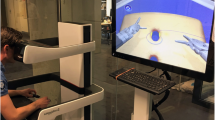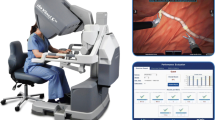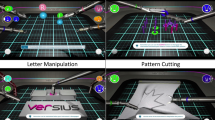Abstract
Background
This study aimed to investigate the effect of a virtual reality simulator on the learning of basic robotic suturing skills.
Methods
Two randomized groups of students underwent a controlled training program. Both groups completed an identical test before and after training. The increase in the number of stitches placed during the pretest and posttest was used as an objective measure of the training effect. To evaluate the subjective feeling of understanding and mastering, the students indicated this on a visual analog scale.
Results
Both groups showed a significant increase in the number of stitches placed during the posttest, and an increase in subjective feeling of understanding and mastering. The increase did not differ between the groups, indicating that the virtual reality simulator equaled the mechanical trainer in training of robotic suturing technique.
Conclusions
Training in basic robot-assisted suturing skills using a virtual reality simulator without additional training equaled training using a mechanical simulator.




Similar content being viewed by others
References
Adrales GL, Chu UB, Witzke DB, Donnely MB, Hoskins D, Mastrangelo MJ Jr, Gandsas A, Park AF (2003) Evaluating minimal invasive surgery training using low-cost mechanical simulations. Surg.Endosc 17: 580–585
Arnold P, Farrel MJ (2002) Can virtual reality be used to measure and train surgical skills? Ergonomics 45: 362–379
Boehm DH, Reichenspurner H, Gulbins H, Detter C, Meiser B, Brenner P, Habazettl H, Reichart B (1999) Early experience with robotic technology for coronary artery surgery. Ann Thorac Surg 68: 1542–1546
Cuschieri A (2001) Training and simulation. Minim Invasive Ther Allied Technol 10: 67–74
DesCoteaux JG, Leclere H (1995) Learning surgical technical skills. Can J Surg 38: 33–38
Dreyfus HL, Dreyfus SE (1986) Mind over machine: the power of human intuition and expertise in the era of the computer. The Free Press, New York, USA
Falk V, Gummert JF, Walther T, Hayase M, Berry GJ, Mohr FW (1999) Quality of computer enhanced totally endoscopic coronary bypass graft anastomosis: comparison to conventional technique. Eur J Cardiothorac Surg 15: 260–265
Garcia-Ruiz A, Gagner M, Miller JH, Steiner CP, Hahn JF (1998) Manual vs robotically assisted laparoscopic surgery in the performance of basic manipulation and suturing tasks. Surg Endosc 133: 957–961
Haluck RS, Krummel TM (2000) Computers and virtual reality for surgical education in the 21st century. Arch Surg 135: 786–792
MacDonald J, Williams RG, Rogers DA (2003) Self-assessment in simulated-based surgical skills training. Am J Surg 185: 319–322
Rogers DA, Elstein AS, Bordage G (2001) Improving continuing medical education for surgical techniques: applying the lessons learned in the first decade of minimal access surgery. Ann Surg 233: 159–166
Satava R (1993) Virtual reality surgical simulator: the first steps. Surg Endosc 7: 203–205
Seymour NE, Gallagher AG, Roman SA, O’Brien MK, Bansal VK, Andersen DK, Satava RM (2002) Virtual reality improves operating room performance: results of a randomized, double-blinded study. Ann Surg 236: 458–464
Shaffer DW, Dawson SL, Meglan D, Cotin S, Ferrel M, Norbash A, Muller J (2001) Design principles for the use of simulation as an aid in interventional cardiology training. Minim Invasive Ther Allied Technol 10: 75–82
Torkington J, Smith SGT, Rees BI, Darzi A (2000) The role of simulation in surgical training. Ann R Coll Surg Eng 82: 88–94
Author information
Authors and Affiliations
Corresponding author
Rights and permissions
About this article
Cite this article
Halvorsen, F.H., Elle, O.J., Dalinin, V.V. et al. Virtual reality simulator training equals mechanical robotic training in improving robot-assisted basic suturing skills. Surg Endosc 20, 1565–1569 (2006). https://doi.org/10.1007/s00464-004-9270-6
Received:
Accepted:
Published:
Issue Date:
DOI: https://doi.org/10.1007/s00464-004-9270-6




